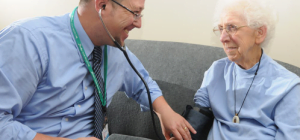 Home health care isn't a new concept. Patients have been receiving supportive services in the home for years, with programs like in-home health and hospice care enabling the elderly and disabled to remain in the comfort of their own homes while receiving the supportive services they need. Physical therapy and occupational therapy, along with other healthcare services such as IV therapy, are provided in the home setting more frequently than ever.
Home health care isn't a new concept. Patients have been receiving supportive services in the home for years, with programs like in-home health and hospice care enabling the elderly and disabled to remain in the comfort of their own homes while receiving the supportive services they need. Physical therapy and occupational therapy, along with other healthcare services such as IV therapy, are provided in the home setting more frequently than ever.
Documentation Errors Impact Patient Outcomes
Providing healthcare in the home setting means that professionals travel from patient to patient, taking the necessary equipment and tools with them as they go. Technology innovations make portable gadgets possible to provide services that once had to be delivered in a hospital. But as in the inpatient and office healthcare setting, thorough documentation is required both for billing purposes and to ensure care continuity. Inaccurate documentation can result in a patient not receiving the appropriate follow-up care or essential services not being provided, sometimes leading to poor patient outcomes.
As the remote patient monitoring and home health care trend continues, healthcare providers are taking advantage of barcode technology to ensure documentation accuracy and streamline the delivery of care. Barcode labels are used to track everything from IV pumps to medication carts, other medical gadgets and supplies.
Providers Save Time with Barcode Labels
Individuals with disabilities may receive in-home physical, occupational or speech therapy, for instance. When therapists visit the home, they have a specific amount of allowable time. In some cases, a therapist can hold off on documentation until after the session is over - but when schedules are tight, there may not be time to properly document all the necessary details between appointments. Every moment spent jotting down equipment used or identification numbers of supplies left in the home is valuable time that could be spent working directly with the patient.
Barcode labels reduce this demand by allowing therapists to quickly scan supplies and devices. It's much more efficient and less error-prone than manually copying supply numbers and other data that can be easily stored in the patient's record with a simple scan. And that means more time spent working on productive activities with the patients they serve.
Easy Re-Ordering with Barcode Labels
Therapists and nurses who work in the field making home visits have to replenish their supplies from time to time. Barcode labels make it possible to re-order essential supplies in just a few clicks, when combined with the right asset management software application. This is far more efficient than calling the main office and repeating 16-digit product codes a few times and hoping no one wrote down an incorrect number. When that happens, providers can easily find themselves out of necessary medical supplies and waiting for several days before the next delivery.
With barcode labels, someone at the physical office can monitor field staff's on-hand supplies via a central database. Some programs can be configured to send an alert message when a product is running low. Providers who work in the field can also easily set up an order for the supplies they'll need to keep in their vehicle for the following week, enabling someone at the main office to prepare it in advance. That means stopping by the office to grab a box or two rather than taking two hours to rummage through the supply closet hoping everything needed is in adequate supply.
Barcode labels have the potential to save home care workers tons of time and significantly reduces the likelihood of documentation errors. Healthcare professionals who aren't frazzled and running late with hectic schedules and last-minute detours to the office can focus all their energy on the most important part of their jobs: Helping the elderly and disabled stay on track with preventative care, properly treat illness and injury, re-gain their physical abilities and above all, live a better, more functional life.
An article documented by Nicole Pontius and published on her behalf. Nicole writes for Camcode durable tags, a company helping users stay systematized and updated on new ways to keep inventory, clients, and employees organized in the work place with security tags resistant to chemicals and extreme temperatures.







